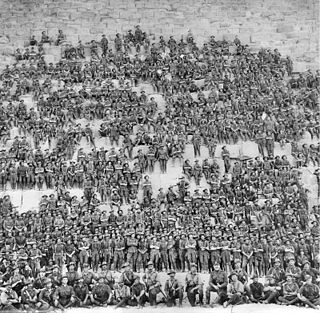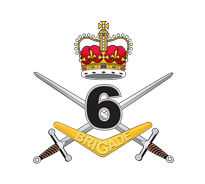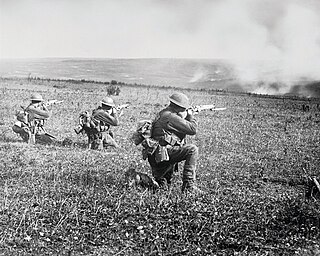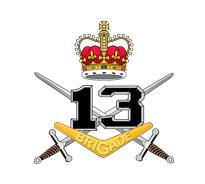
7th Brigade is a combined arms formation or brigade of the Australian Army. The brigade was first raised in 1912 as a Militia formation, although it was re-formed as part of the First Australian Imperial Force in early 1915 for service during World War I. It subsequently saw action at Gallipoli and on the Western Front during the war. Following the end of the war the brigade was disbanded in 1919 before being re-raised in 1921 as part of the Citizens Force. During World War II the brigade took part in the fighting against the Japanese in New Guinea and on Bougainville. Today, the 7th Brigade is part of 1st (Australian) Division and is based in Brisbane, Queensland and is composed mainly of units of the Regular Army. While the brigade has not deployed as a whole unit since World War II, component units have deployed on operations to East Timor, the Solomon Islands, Iraq and Afghanistan.

The 3rd Brigade is a combined arms brigade of the Australian Army, principally made up of the 1st and 3rd Battalions of the Royal Australian Regiment. Initially raised in 1903 as part of the post-Federation Australian Army, it was removed from the order of battle in 1906 following the restructure of the field force. It was re-formed in 1914 for service during World War I, taking part in the fighting at Gallipoli and on the Western Front in Europe. During World War II the brigade was used in a defensive role before it was disbanded in 1944. It was re-raised in 1967 for service during the Vietnam War and later went on to provide the nucleus of the deployment to East Timor during the Australian-led intervention in 1999. The brigade is currently based at Lavarack Barracks in Townsville, Queensland.

The 11th Battalion was an Australian Army battalion that was among the first infantry units raised during World War I for the First Australian Imperial Force. It was the first battalion recruited in Western Australia, and following a brief training period in Perth, the battalion sailed to Egypt where it undertook four months of intensive training. In April 1915 it took part in the invasion of the Gallipoli Peninsula, landing at Anzac Cove. In August 1915 the battalion was in action in the Battle of Lone Pine. Following the withdrawal from Gallipoli, the battalion returned to Egypt where it was split to help form the 51st Battalion. In March 1916, the battalion was deployed to the Western Front in France and Belgium where it took part in trench warfare until the end of the war in November 1918.

The 9th Brigade is a Reserve formation of the Australian Army headquartered at Keswick Barracks in Keswick, South Australia, with elements located in New South Wales and South Australia. The brigade was first raised in 1912 in New South Wales following the introduction of the compulsory training scheme.
The 4th Brigade is a brigade-level formation of the Australian Army. Originally formed in 1912 as a Militia formation, the brigade was re-raised for service during World War I, elements of the brigade served at Gallipoli and in the trenches on the Western Front before being disbanded in 1919. In 1921, the brigade was re-raised as a unit of Australia's part-time military forces, based in the state of Victoria. During World War II the brigade served in the New Guinea and New Britain campaigns. Following the war, the brigade formed part of the 3rd Division, however, it was later reallocated to the 2nd Division, where it serves as a Reserve combined-arms formation including units and personnel from all corps of the Army including armoured, infantry, artillery, engineers, signals and ordnance.

The 20th Battalion was an infantry battalion of the Australian Army. Raised in early 1915 as part of the Australian Imperial Force, it was attached to the 5th Brigade, 2nd Division that served during World War I. The battalion first saw action during the Gallipoli campaign, before being evacuated in December 1915. After that the 20th Battalion was sent to France where they served in the trenches along the Western Front. Over the course of the next two years, they fought in many major battles, including the battles of the Hundred Days Offensive at the end of the war. The 20th Battalion's last engagement was at Montbrehain in October 1918. Following the end of the war, it was disbanded in April 1919. It was later re-raised in 1921, although it was amalgamated in 1929 due to manpower shortages. During World War II the battalion was briefly re-raised and carried out garrison duties in Australia.

The 16th Battalion, Royal Western Australia Regiment is an Australian Army reserve infantry battalion located in Western Australia and one of the two battalions of the Royal Western Australia Regiment. The battalion was first formed during the First World War, during which it fought during the Gallipoli Campaign and on the Western Front in France and Belgium as part of the Australian Imperial Force. It was re-formed as a part-time unit in Western Australia during the inter-war years, and served in the New Britain Campaign against the Japanese during the Second World War. In the post war years, the battalion became part of the Royal Western Australia Regiment and currently forms part of the 13th Brigade.

The 11th Brigade is an Australian Army brigade which currently comprises most Australian Army Reserve units located in Queensland. The brigade was first formed in early 1912 following the introduction of the compulsory training scheme. Later, as part of the 3rd Division and saw action during World War I on the Western Front as part of the First Australian Imperial Force. In the interwar years, the brigade was re-raised with its headquarters in Brisbane.

The 11th/28th Battalion, Royal Western Australia Regiment is a Reserve infantry battalion of the Australian Army. Located in Western Australia, it is one of the two battalions of the Royal Western Australia Regiment which forms the infantry component of the 13th Brigade.

8th Brigade is an Australian Army Reserve training formation. It is headquartered in Sydney, and has subordinate units in various locations around New South Wales and the rest of Australia. These units are tasked with delivering basic and initial employment training to Reserve soldiers.

5th Brigade is a brigade of the Australian Army. Originally raised as a militia formation in 1912, the 5th Brigade was re-raised for overseas service in 1915 as part of the Australian Imperial Force during the First World War. The brigade then served during the Gallipoli Campaign and on the Western Front. During the inter-war years, it was re-raised as a part-time formation as part of Citizens Military Force. It undertook garrison duties in Australia during the Second World War, but was not deployed overseas before being disbanded in 1944. Following the war, the brigade was re-raised in 1948 once again and it is currently a Reserve combined arms formation based in New South Wales and forms part of the 2nd Division.

The 13th Battalion was an infantry battalion of the Australian Army. Originally raised for the 1st Australian Imperial Force during the First World War, it was formed just six weeks after the start of the war. Along with the 14th, 15th and 16th Battalions which were recruited from New South Wales, it formed the 4th Brigade. The battalion saw service initially at Gallipoli before being transferred to France in 1916. For the next two years it fought in the trenches of the Western Front, earning numerous battle honours in the process.

The 6th Combat Support Brigade is an Australian Army brigade. First formed in 1912 as a Militia formation to provide training under the compulsory training scheme, the brigade was re-raised during the First World War as an infantry unit of the all volunteer Australian Imperial Force. It subsequently served at Gallipoli and in France and Belgium on the Western Front. In the 1920s, as part of a reorganisation of the Australian Army, it became part of the 3rd Military District of the Citizens Military Force, encompassing units from Victoria and South Australia. In 1991, it became part of the Ready Reserve Scheme, based at Enoggera Barracks, in Brisbane, Queensland, before being disbanded in 1996 when the scheme was discontinued. The brigade was re-raised on 1 March 2010 to oversee the Army's command support and intelligence, surveillance, target acquisition and reconnaissance units.

The 2nd Health Brigade (2HB) is an Australian Army brigade. The 2nd Brigade was formed in 1903 as a militia infantry formation based in Victoria, the brigade later served during the First World War as part of the Australian Imperial Force, allocated to the 1st Division. During the war, the 2nd Brigade took part in the fighting at Gallipoli, including the Battle of Krithia where it lost almost a third of its strength. Later they took part in the Battle of Lone Pine before being withdrawn back to Egypt in December 1915. Following this the brigade was transferred to the Western Front in France and Belgium where, between March 1916 and the armistice in November 1918, they took part in most of the major Allied operations.

The 14th Brigade was an infantry brigade of the Australian Army. Originally raised in 1912 as a Militia formation, it was later re-raised in 1916 as part of the First Australian Imperial Force for service during World War I, the brigade was assigned to the 5th Division and served on the Western Front between 1916 and 1918 before being disbanded. It was later re-raised as part of the Australia's part-time military forces during the inter-war years. During World War II, the brigade was a Militia formation and it took part briefly in the New Guinea campaign with elements of the brigade undertaking defensive duties around Port Moresby before taking part in the fighting along the Kokoda Track and around the Japanese beachheads at Buna–Gona. The brigade was disbanded in mid-1943 as part of a rationalisation of Australian military forces as a result of manpower shortages.

The 12th Brigade was an infantry brigade of the Australian Army. Formed in 1912 as a Militia formation, it was later re-raised in 1916 as part of the all volunteer First Australian Imperial Force that was raised for overseas service during the First World War. The brigade was part of the 4th Division and fought on the Western Front until the end of the war in November 1918. During the inter-war years, the brigade was re-formed in Australia as a part-time unit; during the Second World War, it was mobilised for full-time service, but did not serve overseas, undertaking garrison duties in Australia until 1945 when it was used to raise Timor Force.

The 52nd Battalion was an infantry battalion of the Australian Army. It was originally raised in 1916 as part of the Australian Imperial Force for service during World War I. After training in Egypt, the battalion took part in the fighting in the trenches of the Western Front in France and Belgium, including major battles at Mouquet Farm, Messines, Polygon Wood, Dernancourt and Villers-Bretonneux. In May 1918, the battalion was disbanded to provide reinforcements for other depleted Australian units. After the war, the battalion was re-raised as a part-time unit in Victoria in 1921 and served until 1930 when it was amalgamated with the 37th Battalion to become the 37th/52nd Battalion. In 1936, the battalion was re-formed and during the early part of World War II it undertook garrison duties in Australia before being merged once again with the 37th Battalion in 1942.

The 28th Battalion was an infantry battalion of the Australian Army. It was raised in early 1915 as part of the First Australian Imperial Force for service during the First World War and formed part of the 7th Brigade, attached to the 2nd Division. It fought during the final stages of the Gallipoli campaign in late 1915 and then on the Western Front between 1916 and 1918. At the end of the war, the 28th was disbanded in 1919 but was re-raised in 1921, as a part-time unit based in Western Australia. During the Second World War, the 28th undertook defensive duties in Australia for the majority of the conflict, before seeing action against the Japanese in the New Britain campaign in 1944–1945. The battalion was disbanded in March 1946 but was re-formed in 1948 as an amalgamated unit with the 16th Battalion, before being unlinked in 1952 and re-raised as a full battalion following the reintroduction of national service. It remained on the Australian Army's order of battle until 1960 when it was subsumed into the Royal Western Australia Regiment, but was later re-raised in 1966 as a remote area infantry battalion. In 1977, the 28th was reduced to an independent rifle company, and in 1987 was amalgamated into the 11th/28th Battalion, Royal Western Australia Regiment.
The 43rd Battalion was an Australian Army infantry unit that was originally formed during the First World War as part of the all-volunteer Australian Imperial Force. Raised in early 1916, the battalion subsequently fought in the trenches of the Western Front from late 1916 until the end of the war in November 1918. After the war, the 43rd was re-raised as a part-time unit in South Australia, serving until 1930 when it was merged with the 48th Battalion. During the Second World War, the 43rd was briefly re-raised between 1942 and 1944, but did not see action before it was disbanded. After the war, the 43rd and 48th were once again merged, existing until 1960 when they became part of the Royal South Australia Regiment.

The 44th Battalion was an infantry unit of the Australian Army. Originally formed in 1916 for overseas service during World War I, the battalion fought in the trenches along the Western Front in France and Belgium between late 1916 and 1918, before disbanding at the conclusion of hostilities. During the inter-war years, the 44th became part of the part-time Citizens Force, based in Western Australia. During World War II, it undertook garrison duties in Australia but was not deployed overseas to fight. In the post-World War II period the 44th was amalgamated with the 11th Battalion, before being subsumed into the Royal Western Australia Regiment in 1960.




















